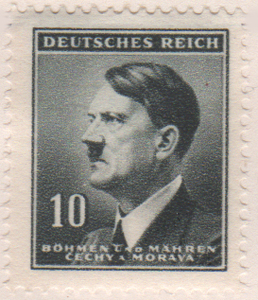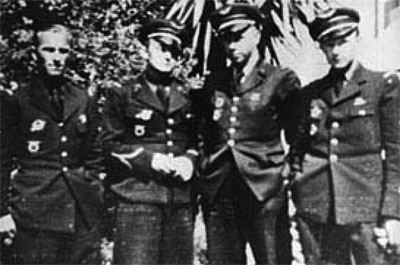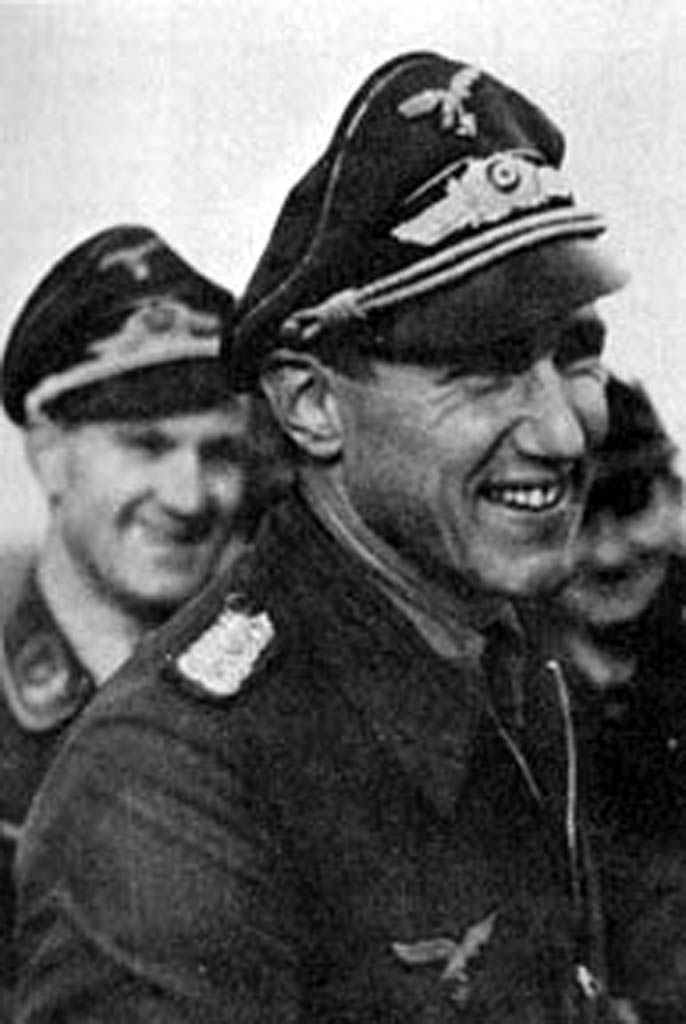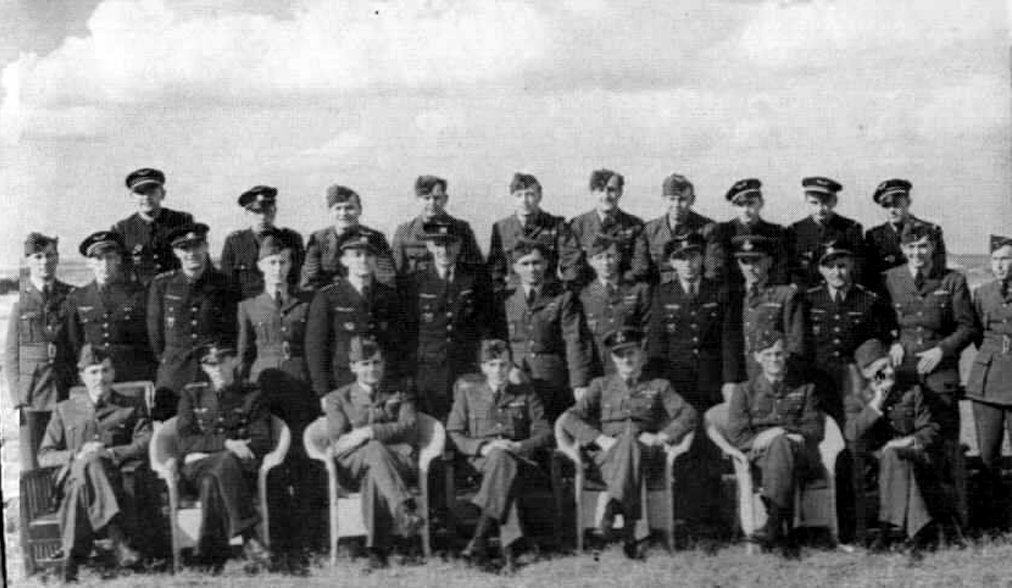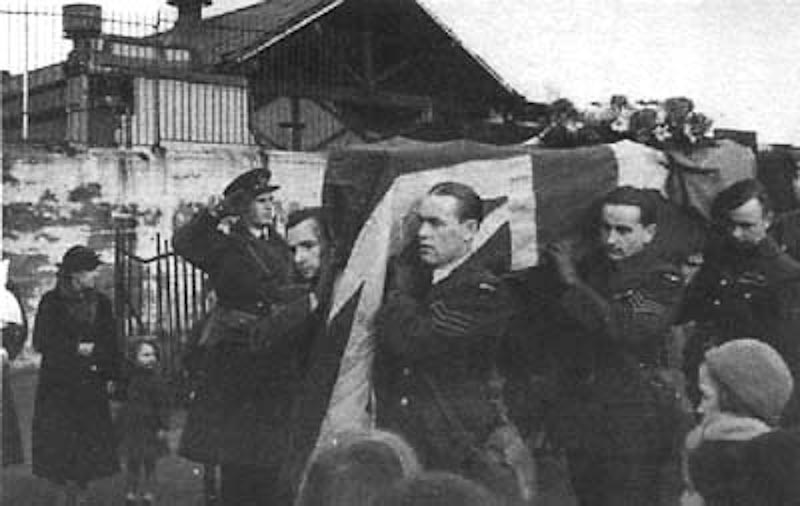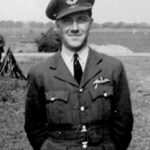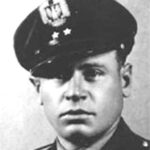Born in 1911 in a politically contentious place – a city in Austria-Hungary that became Czechoslovakian in 1918, and then subject to German expansionist desires that led to Nazi occupation – the causal politics of World War II were embedded in the life of Otto Hanzlíček.
Volunteering for Czechoslovak air force in 1930, he was an experienced Sergeant and fighter pilot by the time of the Nazi invasion. He escaped to France where he joined the French air force in summer 1939. Having shot down German planes, and survived being shot down in return, as France fell he escaped to the UK.
Like Jindřich Bartoš, he joined the RAF’s No 312 (Czechoslovak) squadron and was posted to RAF Speke in Liverpool, charged with escorting shipping convoys and defending the city. Two weeks later on a training flight in the oldest Hurricane in sevice, his engine caught fire and he baled out into the River Mersey and was drowned, aged 29.
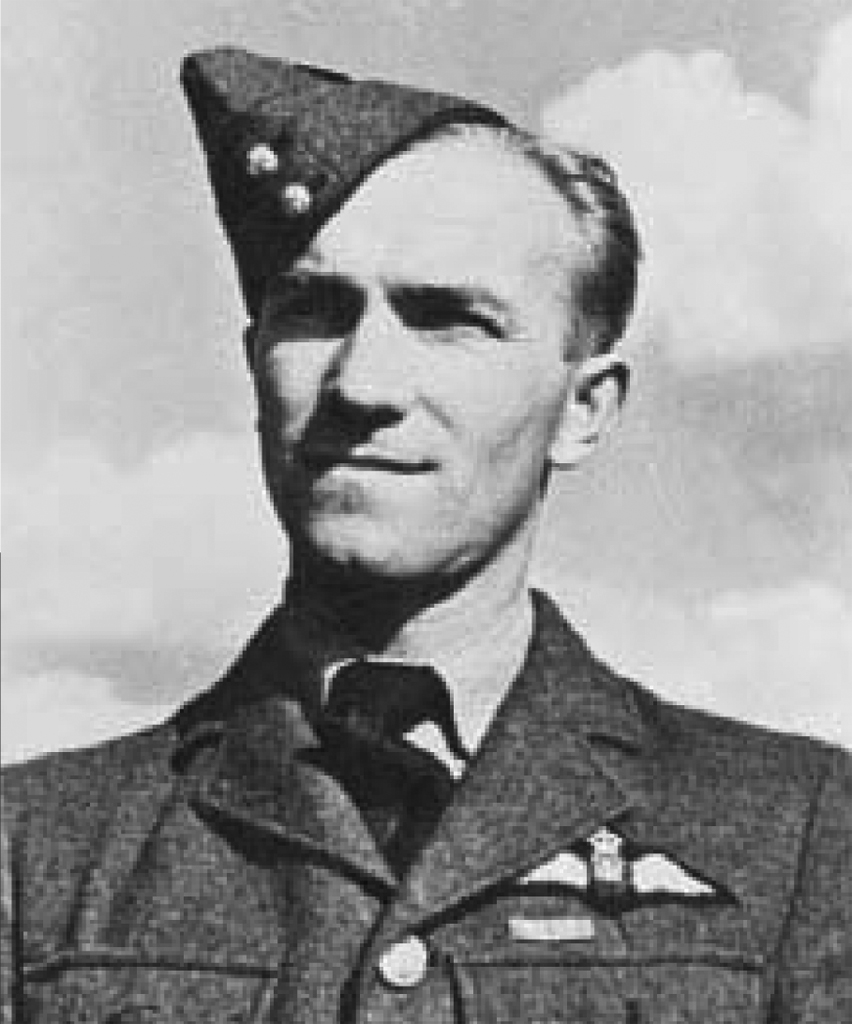
Introduction
Otto Hanzlíček is one of the three Merseyside Few who are clearly not from Liverpool or Wirral. He is buried in West Derby Cemetery, section 11 RC grave 392 with a compatriot, Jindřich Bartoš.
West Derby Cemetery, in Lower House Lane, Croxteth [Google map], is a sprawling mass of graves, some well maintained and some not. The cemetery was opened in January 1884 and consecrated six months later on 28 June. It has been used for both Church of England and Roman Catholic burials and a number of its buildings have been accorded Grade II listed status.
Just inside the entrance is one of those signs showing a map of the cemetery and its sections. These things are never easy to follow as the sections themselves are not marked at all. It turned out that Hanzlíček’s grave was about as far from the cemetery gates as you can get but I was pleased to see it was well maintained.
So who was Otto Hanzlíček and how did he come to be buried on Merseyside?
Background – Early Life
Otto Hanzlíček was born on 18 June 1911 at 21 Straße Sandhöhe / Ktinigshtihe in Ústí nad Labem [Google map], an ethnically German and Czech city in Austria-Hungary. He was the eldest of two children, his sister Jirana being three years younger than him.
Ústí nad Labem is in the region of Bohemia, about 80km north of Prague close to the border with Germany (also known as the Sudetenland, its majority population being ethnic Germans). After World War I, Bohemia became the core of the newly formed country of Czechoslovakia. Under its first president, Tomas Masaryk, the country was a liberal democratic republic.
However, serious issues were emerging around the Czechoslovakian people’s relationship with the native Germans. These issues would come to a head in the most brutal fashion in 1938.
Otto Hanzlíček trained as a mechanic but always maintained an interest in aviation. This led to him volunteering for the Czechoslovak Air Force in 1930. He attended the Military Aviation School in Prostejov [Google map] where he trained with 15th Squadron 4th Aviation Regiment. His graduation was confirmed on 7 January 1932.
In 1934 he was transferred to Aviation Regiment No 3 in Vajnory, near Bratislava [Google map]. After completion of fighter pilot training and promotion to Seargent in August 1935 he flew fighters for 37th Fighter Squadron at Piestany [Google map].
Escaping the Nazi Occupation of Czechoslovakia
The gathering storm clouds of war cast a shadow over Czechoslovakia and on 10 October 1938 it was incorporated directly into the Reich when the country was forced by Nazi Germany to accept the terms of the Munich Agreement.
The remnants of Bohemia and Moravia were then annexed by Germany in 1939. From 1939 to 1945 Bohemia and Moravia formed the German Reichsprotektorat Bohmen und Mahren (Protectorate of Bohemia and Moravia). Any open opposition to German occupation was brutally suppressed by the Nazi authorities and many Czechoslovakian patriots were executed as a result.
Clearly this was no place for Otto Hanzlíček so he flew to Prague where he had been included in the National Research Institute of Aviation in the Letňany district having amassed a total flying time of 812 hours 28 minutes.
He stayed with his sister Jirana who had fled occupied Ústí nad Labem with the rest of his family after the Nazis had begun searching out families of Czechoslovak airmen for deportation.
Hanzlíček had clearly made plans to escape the Nazi occupation of his homeland. With two friends he headed for Ostrava [Google map], which was close to the Polish border, and on 8 June 1939 managed to cross into Poland.
From Kraków he made his way to Gdynia [Google map] on the south coast of the Baltic Sea. On 25 July, just 8 weeks before the Germans occupied the city, he caught a ship to France where he landed at Calais on 31 July 1939. From here he was transferred to Paris.
The Battle of France
As France was not yet at war with Germany, Hanzlíček was given a passport and, with other immigrants, expected to join the French Foreign Legion. Refusal to do this would have led to repatriation to Czechoslovakia. Once war was declared he was transferred to the Armee de l’Air.
After retraining on French aircraft at the fighter school at Chartres, south-west of Paris [Google map], he was posted to Groupe de Chasse II/5 at Toul Croix-de-Metz near the German border [Google map] in December 1939. Initially flying Curtiss Hawk 75 – an American-built fighter, contemporaneous with the Hawker Hurricane and Messerschmitt Bf109 – he started off on fighter escort missions for bombers. His first recorded kill was a Dornier Do17P on 24 April 1940.
On 10 May 1940 Hitler commenced Operation Fall Gelb, his anticipated assault on Western Europe.
On 11 May 1940 Hanzlíček shared a Heinkel He111H of 2/Kampfgeschwader 53 (the infamous Condor Legion) bringing it down at Bois de Chene, 100km east of Toul on the German border [Google map].
Then on 18 May 1940 he shared a Bf109 with French pilot Lt G Ruchouxem. Immediately Hanzlíček himself was attacked by another Bf109. The pilot of this particular Messerschmitt was none other than Luftwaffe ace Günther Rall of 8/JG 52, who would end the war with 275 confirmed victories.
Rall blasted Hanzlíček’s plane causing it to burst into flames. Hanzlíček was forced to bail out and was fortunate to parachute to safety. The loss of his plane is reported to be Günther Rall first recorded kill.
Otto Hanzlíček made 113 flights totalling over 100 hours for the Armee l’Air for which he was awarded the Croix de Guerre with Silver Star and bar and the Czechoslovak War Cross.
On 18 June 1940 Winston Churchill told the British Parliament, “What General Weygard called The Battle of France is over. The Battle of Britain is about to begin”. Otto Hanzlíček having fought in the first battle was about to join the second.
The Battle of Britain
Having escaped from Czechoslovakia, Hanzlíček now had to escape from France and find his way to Britain. Along with other Czechoslovak pilots he managed to get to North Africa. On 9 July 1940 he sailed from Casablanca on the Royal Scotsman to Gibraltar, where he transferred to the David Livingstone, and on 21 July sailed for Cardiff where he arrived on 5 August 1940. This is the same route and day the other Czechoslovak pilot of the Merseyside Few, Jindřich Bartoš. He would join the same squadron as Bartoš six weeks later and was destined to share the same grave.
It is not clear whether the men knew each other on the journey to Britain, or perhaps even whilst flying in France, but it’s easy to imagine that two Czechoslovakian pilots on the same long boat trip would find one another and have plenty to talk about.
No 312 (Czechoslovak) Squadron came into being as the second Czechoslovak fighter unit in the RAF and was formed on 29 August 1940 at the Czechoslovak aircrew depot at RAF Cosford. The squadron’s motto was ‘non multi sed multa’, meaning ‘not many but much’. The squadron badge was a stork volant, a reference to the French ‘Escadrille des Cygelines’ with whom the original pilots of the squadron had flown prior to coming to the UK.
The home base of the squadron was RAF Duxford in Cambridgeshire, the same airfield where No 310 (Czechoslovak) Squadron was based. On 31 August the first nine used MkI Hawker Hurricanes were flown into Duxford and on 4 September 1940 a MkI Miles Master joined them. Czechoslovak airmen, including Jindrich Bartos, arrived at RAF Duxford with other Czechoslovak flying personnel and ground staff during afternoon of 5 September 1940.
Otto Hanzlíček joined the RAF Volunteer Reserve and was given the service number 787697. On 19 September 1940 he was posted to No 312 (Czechoslovak) Squadron. Based around battle hardened pilots who already had combat experience in the Battle of France, many of whom with more than one victory, the squadron was ready for action.
So it was on 26 September it moved to its new home, the RAF station at Speke, Liverpool [Google map]. Here the unit completed its retraining and in the last days of September obtained further Hurricanes. The squadron was allocated a number of older aircraft, something that caused many servicing difficulties. On 2 October 1940, No 312 (Czechoslovak) Squadron was declared operational and its task was to protect the Liverpool area from enemy raids.
The squadron was most heavily involved in night patrols defending Liverpool docks. At 23:50 hours on 7 October Speke Aerodrome itself was attacked and an Audax aircraft was completely wrecked and a Douglas DF7 was damaged. Some windows in the hangars were broken, but the aerodrome remained serviceable although only half the squadron was operational.
On 8 October 1940, pilots had shot down their first enemy aircraft, a Junkers Ju88 that had tried to attack the Rootes aircraft factory on the perimeter of the airfield. The factory manufactured Halifax bombers. The Ju88 crashed on the opposite bank of the River Mersey at Brombrough, on the Wirral. This victory was recorded as probably the fastest kill of the war, taking around eleven minutes from take-off to landing and was watched by Squadron personnel and many local residents.
Death and Funeral
On 10 October 1940, Hanzlíček took off from Speke in the oldest Hawker Hurricane in service, L1547, along with Pilot Officer Dvořák on practice enemy aircraft attacks in the Liverpool area.
As he banked round to return near Ellesmere Port on the opposite bank of the Mersey, less than three miles from Speke, the engine of his aircraft caught fire and he was forced to bale out near Oglet [Google map]. The wind blew him out over the River Mersey and, after problems with his parachute due to bailing out too low, he fell into the water, some 300-400 yards from the river bank bank and was drowned.
Mr Alan Davie, who lives in Liverpool was a British member of No 312 (Czechoslovak) squadron serving at Speke, had vivid memories of the moment the aircraft crashed into the river:
“I had just returned from lunch when I heard the sound of engines approaching. I thought it was the Germans as they had flown in a few days earlier and tried to bomb the airport, but our lads had shot them down. When I realised what was happening, I just put my hands together and said a prayer. I saw the Hurricane and pilot falling from the sky. If the wind had been kind to him, he could have landed in Ellesmere Port and survived. He fell into the river and his parachute was falling from the sky behind him. As he went into the water he went under but then came back to the surface. As he did, his parachute came down on top of him. I witnessed some horrific sights during my time in the air force, but that particular day is one I will never forget.”
He was seen to fall into the water on the North side of the river by a farmer near Oglet, but when he arrived at the river bank ten minutes later there was nothing to be seen. His aircraft came down into the river off the end of runway 08 and had been seen to be emitting smoke over the river just opposite the airfield by personnel at the station.
Three weeks later, on 1 November 1940, Otto Hanzlíček’s body was found five miles to the east of Speke at Widnes. On 4 November the inquest into the cause of his death was held at Widnes [Google map], the finding of which was “Death due to Asphyxia from drowning”.
At the age of 29, Sgt Hanzlíček was the first pilot to be killed from No 312 (Czechoslovak) squadron. At the time of the accident he had 930 flying hours to his credit, with seven of these on Hurricanes.
On the morning of 5 November 1940 Hanzlíček’s funeral was held at the Roman Catholic Church in Allerton when, after a short service, he was taken to West Derby Cemetery. His coffin was draped with the Union Jack and Czechoslovak flags on which rested his Croix De Guerre. He was buried in Section RC11 grave No 392. The stone gives his name as Otta Hanzlíček.
Jindřich Bartoš, the other Czechoslovak pilot in the Merseyside Few, and whose career was intertwined with Hanzlíček’s, was killed on 13 February 1941 whilst on a training flight. He was buried in the same grave as Hanzlíček, and they share a headstone.
Memorials
Sergeant Otto Hanzlíček is remembered on the Battle of Britain Monument in London, the Battle of Britain Memorial in Capel-le-Ferne on the white cliffs of Dover, a plaque at the RAF Museum at Hendon and a plaque at the Czech Club in London. Most recently there has been a street named after him in his home town of Ústí nad Labem, Hanzlíčkova [Google map].
Otto Hanzlíček was born in a fledgling nation, a liberal nation that should have allowed him to reach his potential and fulfil his ambitions. Such dreams destroyed, he was forced to flee his country. When the opportunity came to stand up to his oppressors he grasped it, going head to head with them in the skies above northern France. Pushed back again, he stood side by side with the young fighter boys of the RAF in defence of Great Britain. Posted to the North West of England, his job was to repel enemy raiders and help prevent an invasion. It was a job he gave his life for.
Otto Hanzlíček is buried on Merseyside because he gave his life defending it. For this the Merseyside Few is eternally grateful.
The First Production Hurricane
Hurricane L1547, which Otto Hanzlíček piloted on his final flight, was the first production aircraft built by Hawker Aircraft Ltd of Kingston and Brooklands to Air Ministry specification F.15/36 under contract No 527112/36. The first 430 aircraft were manufactured with fabric covered wings and the remaining 170 with metal covered wings. However, some aircraft later re-fitted with metal wings at maintenance Units within the RAF. Deliveries of aircraft for this order commenced on 15 December 1937 and were completed on 6 October 1939.
L1547 first flew on the 12th October 1937 at Hawker’s Brooklands factory. It was flown by Phillip Lucas, Flight Lieutenant P.W.S. Bulman’s assistant test pilot, and subsequently was used for flying performance and engineering trials at various establishments before entering Squadron service.
L1547
First flown on 12/10/1937
Taken on charge by Hawkers on 29/03/1938
Taken on charge by A&AEE on 23/06/1938
Taken on charge by Rolls Royce on 28/06/1938
Taken on charge by A&AEE on 21/07/1938
Taken on charge by No 15 MU on 29/05/1940
Taken on charge by No 10 MU on 10/06/1940
Taken on charge by No 312 (Czechoslovak) Squadron on 31/08/1940
Fatal accident on 10/10/1940
Struck off charge on 29/10/1940
Here is a performance report on the Hurricane from April 1936.
Up until the 1970s aircraft wreckage believed to be from this Hurricane could be seen at low tide, but has now disappeared into the ever-shifting deep mud, and it is thought that the remains are now buried under ballast of a light gantry for the airport.
A few pieces of the aircraft were recovered in the 1960s when a couple of spars were showing about 50 yards out and these are now at the War Plane Wreck Museum at Fort Perch Rock, New Brighton. The canopy was apparently found on Cartwright’s farm and went to No 7F Squadron ATC in Liverpool. However, although aware of the story, they don’t have possession of the canopy any more.
Prostějov Memorial
When the war ended, relatives of some of the 513 Czechoslovak airmen who died whilst serving in the RAF wanted the remains of their loved ones returned to Czechoslovakia for burial. When the practicalities of doing this were investigated Brigadier General Karel Janoušek, Head of the Czechoslovak Air Force in the UK, said it would be too expensive to exhume each body so suggested it would be better to have a symbolic exhumation instead.
A sample of soil from each of the airmens’ graves was taken and transported to Czechoslovakia to be placed into new urns before being formally interred. Graves left in the original cemeteries in the United Kingdom would have a standard type of British military headstone.
The urns from the British graves of Czechoslovak RAF airmen were moved to Prague. They were then stored in boxes whilst plans for an appropriate memorial were considered. In February 1948 the Communists took control of Czechoslovakia and those who had fought in the West for the freedom of their homeland now found themselves to be victims of persecution. Under this new regime the urns were simply forgotten.
On 15 January 1990, during the reconstruction of a National Monument at Vítkov, Prague, workmen discovered boxes which contained the 302 wooden urns. Unfortunately, due to poor storage conditions, 63 of the urns had rotted and their contents had mixed together. The mixed soil was placed in one communal urn. The contents of the remaining 239 urns were placed in new urns.
The urn with soil from Otto Hanzlíček grave was placed at the memorial at Ústí nad Labem.
As with Wladyslaw Szulkowski, South Lancashire Aviation’s exhaustive site has a wealth of research on Otto Hanzlíček and this forms much of the content on The Merseyside Few. Despite several attempts to contact them I received no reply, and I hope that my use of their material will be taken in a spirit of furthering the honouring of these pilots.
Asistance from the Free Czechoslovak Airforce Associates Ltd was tremendously helpful in pulling together material from a number of sources worldwide. Take some time to look at their website.
Books:
The Battle of Britain Then and Now (Fifth Edition) – Winston G Ramsey
Battle Over Britain – Francis K Mason
Men of The Battle of Britain – Ken Wynn
Eyes of the Night: The Air Defence of North Western England 1940-1943 – Joe Bamford & Ron Collier
Comments are closed


